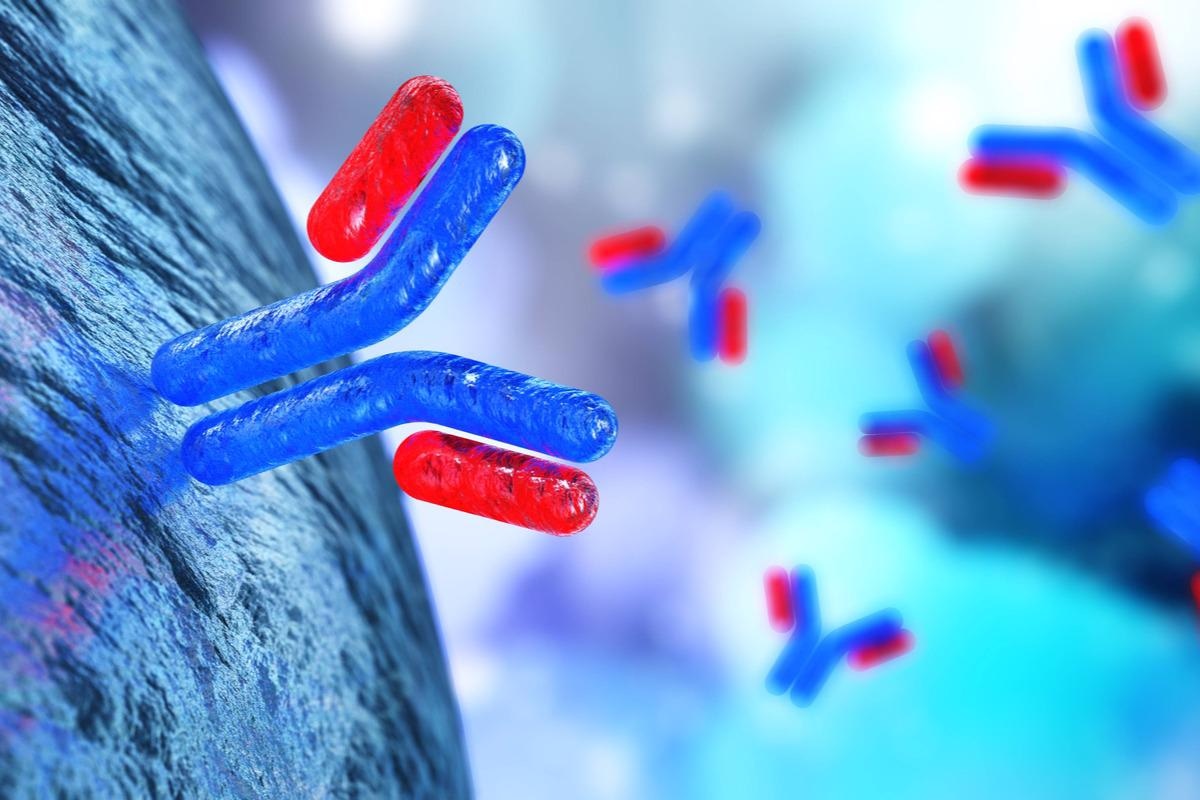In a recent study published in Science Translational Medicine, researchers identified 10-40, a human monoclonal antibody (mAb) with potent neutralizing activity against severe acute respiratory syndrome coronavirus (SARS-CoV), SARS-CoV-2 and related sarbecoviruses.
 Study: An antibody class with a common CDRH3 motif broadly neutralizes sarbecoviruses. Image Credit: ustas7777777/Shutterstock
Study: An antibody class with a common CDRH3 motif broadly neutralizes sarbecoviruses. Image Credit: ustas7777777/Shutterstock
The emergence of multiple SARS-CoV-2 variants with enhanced transmission and immune evasive properties has underpinned the need for mAbs that can neutralize SARS-CoV-2 and all sarbecoviruses, enhancing the preparedness for coronavirus disease 2019 (COVID-19) and future pandemics.
About the study
In the present study, researchers identified a human monoclonal antibody, 10-40, that neutralized all sarbecoviruses tested in vitro and protected against SARS-CoV-2 and SARS-CoV in vivo.
Serum samples of convalescent SARS-CoV-2-infected patients were obtained to screen for broadly neutralizing and potent mAbs. Subsequently, SARS-CoV-2 Beta strain spike (S) protein–targeted memory B lymphocytes of two patients (who demonstrated SARS-CoV and SARS-CoV-2 neutralization) were analyzed. Subsequently, single-cell ribonucleic acid (RNA) sequencing was performed to assess the light and heavy chain pairs of the mAb sequences.
Epitope mapping of the three most potent mAbs was performed using enzyme-linked immunosorbent assays (ELISA) with nine other S receptor-binding domain (RBD)-targeted mAbs which have previously demonstrated broad neutralizing activity against sarbecoviruses. The nine mAbs were DH1047, S2X259, REGN10985, ADG-2, 2-36, COVA1-16, CR3022, S2H97, and S309. The neutralization potency and breadth of mAbs against SARS-CoV and SARS-CoV-2 were assessed using neutralization assays.
The neutralizing activity of mAbs against ten sarbecoviruses was assessed using pseudotyped virus assays. In addition, the mAb binding affinities to SARS-CoV S and SARS-CoV-2 S were measured based on their surface plasmon resonance (SPR). Furthermore, structural analysis was performed using cryo-electron microscopy (cryo-EM) and x-ray crystallography. Lastly, the in vivo efficacy of 10-40 was assessed in wild-type mice and human angiotensin-converting enzyme 2 (hACE2)-transgenic mice intranasally challenged with MA10 (mouse-adapted SARS-CoV-2 strain) and SARS-CoV, respectively.
Results
In the comparative analysis, most mAbs targeted a similar region of SARS-CoV-2 S RBD; however, the epitope and angle of approach of the mAbs varied. Therefore, the neutralization potency and breadth of the mAbs were substantially different. In the single-cell RNA sequencing analysis, the heavy chains of 10-40, 11-11, and 10-28 mAbs were derived from the immunoglobulin heavy variable 4-39 (IGHV4-39*01), IGHV4-31*03 and IGHV3-30*18 genes. The corresponding light chains were derived from IGLV6-57*01, IGLV1-40*01, and IGKV1-39*01 genes, respectively. All the three mAbs demonstrated low somatic hypermutations.
Furthermore, 10-40 and other broadly neutralizing mAbs demonstrated a common motif in their heavy-chain complementarity-determining region 3 (CDRH3) gene, indicating that the mAbs could be elicited generally. Notably, 10-40 showed in vivo efficacy against both SARS-CoV and SARS-CoV-2, indicating that 10-40 could be used as a part of the anti-SARS-CoV-2 therapeutic landscape. The 10-40, 11-11, and 10-28 mAbs were bound to SARS-CoV-2 D614G strain S and Beta S and to SARS-CoV S. All three mAbs recognized S RBD epitopes and prevented the S-hACE2 binding.
In the epitope mapping analysis, the 10-40, 11-11, and 10-28 mAbs with seven other mAbs recognized the inner face of RBD in the up conformation. The S309 epitope was discrete, whereas the S2H97 epitope partially overlapped with an epitope on the outer face of RBD.
In the neutralization assays, all mAbs (with the exception of CR3022) neutralized all the tested strains of SARS-CoV-2, among which ADG-2 demonstrated the highest potency, followed by DH1047, 10-40, REGN10985, S309, and S2X259 whereas 2-36, 10-28, COVA1-16 and 11-11 were less potent. Almost all mAbs (except S2H97) were adversely affected by the SARS-CoV-2 Omicron variant; however, 10-40 could completely neutralize Omicron at the highest dose. Against SARS-CoV, 10-40, ADG-2, DH1047, and S2X259 showed potent neutralization. In the pseudotyped virus assays, only DH1047 and 10-40 mAbs neutralized all the sarbecoviruses. None of the mAbs neutralized the Middle East respiratory syndrome (MERS) virus.
In the binding affinity assessments, 10-40, S2H97, and 10-28 mAbs were bound to RBDs of all the six sarbecoviruses located beyond the SARS-CoV and SARS-CoV-2 sublineages. 10-40, 2-36, DH1047, and 10-28 were bound to S of sarbecoviruses derived from Asian bats. The structural analysis showed that 10-40 bound to a highly conserved epitope that enabled similar binding of 10-40 to RaTG13, WIV1, and SHC014 sarbecoviruses and SARS-CoV-2, and most of the binding interactions were via the CDRH3 and CDRL2 motifs. Compared to SARS-CoV-2, additional salt bridges and hydrogen bonds were present between 10-40 and the sarbecoviruses, which enabled broad recognition of 10-40 for sarbecoviruses.
In the mice experiments, MA10 RBD mutations (Q498Y, P499T, and Q493K) were mapped beyond the 10-40 mAb epitope and, therefore, did not substantially affect 10-40 neutralizing activity in vitro. 10-40 administration substantially prevented weight loss and led to remarkable reductions in pulmonary SARS-CoV-2 and SARS-CoV titers in wild-type mice and hACE2-transgenic mice, respectively.
Conclusion
Overall, the study findings showed that the 10-40 mAb has promising potential as a broad and potent neutralizing mAb that could be used for pandemic preparedness and to develop a pan-sarbecovirus vaccine.